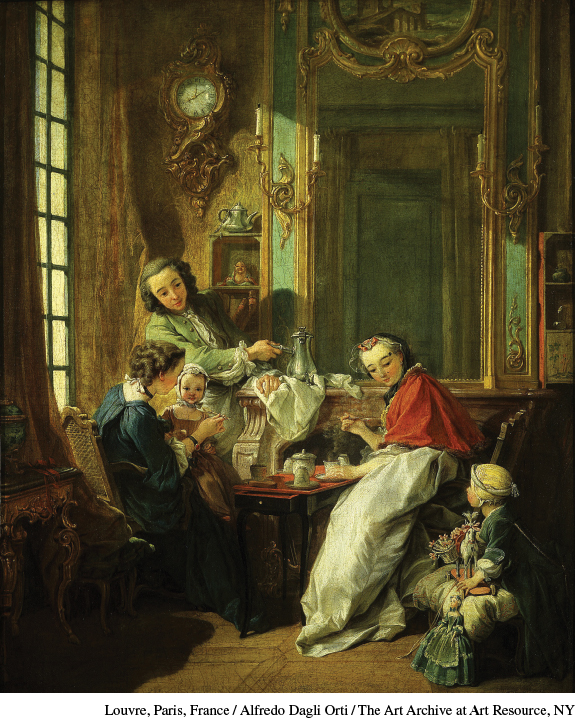New Tastes in the Arts
New Tastes in the Arts
The new literate public did not just read newspapers; its members now pursued an interest in painting, attended concerts, and besieged booksellers in search of popular novels. Because increased trade and prosperity put money into the hands of the growing middle classes, a new urban audience began to compete with the churches, rulers, and courtiers as chief patrons for new work.

Developments in painting reflected the tastes of the new public, as the rococo style challenged the hold of the baroque and classical schools, especially in France. Rococo, like baroque, was an invented word (from the French word rocaille, “shellwork”) and originally a derogatory label, meaning “frivolous decoration.” Many rococo paintings depicted scenes of intimate sensuality rather than the monumental, emotional grandeur favored by classical and baroque painters. Personal portraits and pastoral paintings took the place of heroic landscapes and grand, ceremonial canvases. Rococo paintings adorned homes as well as palaces and served as a form of interior decoration rather than as a statement of piety. Its decorative quality made rococo art an ideal complement to newly discovered materials such as stucco and porcelain, especially the porcelain vases now imported from China.
Public music concerts were first performed in England in the 1670s and became much more regular and frequent in the 1690s. On the continent, Frankfurt organized the first regular public concerts in 1712; Hamburg and Paris began holding them within a few years. Opera continued to spread in the eighteenth century; Venice had sixteen public opera houses by 1700, and the Covent Garden opera house opened in London in 1732.
The growth of a public that appreciated and supported music had much the same effect as the extension of the reading public: like authors, composers could now begin to liberate themselves from court patronage and work for a paying audience. The composer George Frideric Handel (1685–1759) was among the first to grasp the new directions in music. A German by birth, Handel wrote operas in Italy and then moved in 1710 to Britain, where he wrote music for the court and began composing oratorios. The oratorio, a form Handel introduced in Britain, combined the drama of opera with the majesty of religious and ceremonial music and featured the chorus over the soloists. The “Hallelujah Chorus” from Handel’s oratorio Messiah (1741) is perhaps the single best-known piece of Western classical music. It reflected the composer’s personal, deeply felt piety but also his willingness to combine musical materials into a dramatic form that captured the enthusiasm of the new public.
Nothing captured the imagination of the new public more than the novel, the literary genre whose very name underscored the eighteenth-century taste for novelty. More than three hundred French novels appeared between 1700 and 1730. During this unprecedented explosion, the novel took on its modern form and became more concerned with individual psychology and social description than with the adventure tales popular earlier (such as Miguel de Cervantes’s Don Quixote). The novel’s popularity was closely tied to the expansion of the reading public, and novels were available in serial form in periodicals or from the many booksellers who served the new market.
Women figured prominently in novels as characters, and women writers abounded. The English author Eliza Haywood (1693?–1756) earned her living turning out a stream of novels with titles such as Persecuted Virtue, Constancy Rewarded, and The History of Betsy Thoughtless—all showing a concern for the proper place of women as models of virtue in a changing world. Haywood’s male counterpart was Daniel Defoe (1660–1731), a merchant’s son who had a diverse and colorful career as a manufacturer, political spy, novelist, and social commentator. Defoe is best known for his novel Robinson Crusoe (1719). The story of the adventures of a shipwrecked sailor, Robinson Crusoe portrayed the new values of the time: to survive, Crusoe had to employ fearless entrepreneurial ingenuity. He had to be ready for the unexpected and be able to improvise in every situation. He was, in short, the model for the new man in an expanding economy. Crusoe’s patronizing attitude toward the black man Friday now draws much critical attention, but his discovery of Friday shows how the fate of blacks and whites had become intertwined in the new colonial environment.